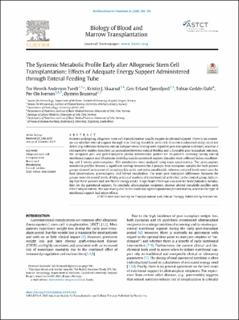| dc.contributor.author | Tvedt, Tor Henrik Anderson | |
| dc.contributor.author | Skaarud, Kristin Aneta Joan | |
| dc.contributor.author | Tjønnfjord, Geir Erland | |
| dc.contributor.author | Gedde-Dahl, Tobias | |
| dc.contributor.author | Iversen, Per Ole | |
| dc.contributor.author | Bruserud, Øystein | |
| dc.date.accessioned | 2021-05-20T11:06:36Z | |
| dc.date.available | 2021-05-20T11:06:36Z | |
| dc.date.created | 2020-01-13T13:48:03Z | |
| dc.date.issued | 2020 | |
| dc.Published | Biology of Blood and Marrow Transplantation. 2020, 26 (2), 380-391. | |
| dc.identifier.issn | 1083-8791 | |
| dc.identifier.uri | https://hdl.handle.net/11250/2755851 | |
| dc.description.abstract | Patients undergoing allogeneic stem cell transplantation usually require nutritional support. There is no consensus on whether enteral support through tube feeding should be preferred. A recent randomized study could not detect any difference between enteral and parenteral feeding with regard to post-transplant outcomes, whereas 2 retrospective studies described an association between enteral feeding and a favorable post-transplant outcome. We compared pre- and post-transplant plasma metabolomic profiles for 10 patients receiving mainly enteral nutritional support and 10 patients receiving mainly parenteral support. Samples were collected before conditioning and 3 weeks post-transplant; 824 metabolites were analyzed using mass spectrometry. The pretransplant metabolite profiles showed a significant overlap between the 2 groups. Post-transplant samples for both patient groups showed an increase of secondary bile acids and endocannabinoids, whereas reduced levels were seen for food preservatives, plasmalogens, and retinol metabolites. The main post-transplant differences between the groups were decreased levels of fatty acids and markers of mitochondrial activation in the control group, indicating that these patients had insufficient energy intake. A significant effect was also seen for heme/bilirubin metabolism for the parenteral support. To conclude, allotransplant recipients showed altered metabolic profiles early after transplantation; this was mainly due to the conditioning/transplantation/reconstitution, whereas the type of nutritional support had minor effects. | en_US |
| dc.language.iso | eng | en_US |
| dc.publisher | Elsevier | en_US |
| dc.rights | Attribution-NonCommercial-NoDerivatives 4.0 Internasjonal | * |
| dc.rights.uri | http://creativecommons.org/licenses/by-nc-nd/4.0/deed.no | * |
| dc.title | The systemic metabolic profile early after allogeneic stem cell transplantation: Effects of adequate energy support administered through enteral feeding tube | en_US |
| dc.type | Journal article | en_US |
| dc.type | Peer reviewed | en_US |
| dc.description.version | publishedVersion | en_US |
| dc.rights.holder | Copyright 2019 American Society for Transplantation and Cellular Therapy | en_US |
| cristin.ispublished | true | |
| cristin.fulltext | original | |
| cristin.qualitycode | 1 | |
| dc.identifier.doi | 10.1016/j.bbmt.2019.10.005 | |
| dc.identifier.cristin | 1771503 | |
| dc.source.journal | Biology of Blood and Marrow Transplantation | en_US |
| dc.source.40 | 26 | |
| dc.source.14 | 2 | |
| dc.source.pagenumber | 380-391 | en_US |
| dc.identifier.citation | Biology of Blood and Marrow Transplantation. 2020, 26(2), 380-391 | en_US |
| dc.source.volume | 26 | en_US |
| dc.source.issue | 2 | en_US |

